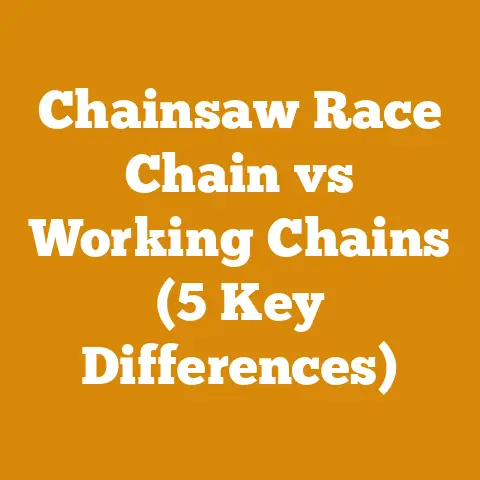7 Stages of Wood Processing (5 Expert Steps for Perfect Grain)
Blending styles in wood processing are as diverse as the types of wood we work with.
Some prefer the raw, rustic charm of minimal intervention, letting the wood’s natural character shine.
Others lean towards meticulous control, striving for flawless surfaces and perfect dimensions.
I’ve always found myself somewhere in between, appreciating the beauty of imperfection while recognizing the value of precision.
Achieving this balance, however, requires more than just a good eye and a steady hand.
It demands a system, a way to measure our progress and understand the impact of our choices.
That’s where tracking project metrics comes in.
In this article, I’ll walk you through seven crucial stages of wood processing and five expert steps for achieving perfect grain, all while highlighting the key performance indicators (KPIs) that will guide you toward success.
The Importance of Tracking Metrics in Wood Processing
Why bother tracking metrics?
Because in the world of wood processing and firewood preparation, what gets measured gets managed.
Without a clear understanding of your costs, timelines, and yields, you’re essentially flying blind.
I learned this the hard way early in my career.
I was convinced I was running a profitable firewood business, only to discover later that hidden inefficiencies were eating away at my margins.
It wasn’t until I started meticulously tracking my time, expenses, and wood volume that I truly understood where my business was succeeding and where it was falling short.
This article is about preventing that kind of painful realization.
By the end, you’ll have the tools and knowledge to make data-driven decisions that improve efficiency, reduce waste, and ultimately boost your bottom line.
7 Stages of Wood Processing and Key Metrics
Let’s break down the wood processing journey into seven distinct stages, each with its own set of crucial metrics:
1. Harvesting/Sourcing
This is where it all begins.
Whether you’re felling trees yourself or purchasing logs from a supplier, the initial sourcing stage has a significant impact on the rest of the process.
Metric 1: Wood Volume Yield (Cubic Feet/Meters per Tree/Log)
- Definition: The usable volume of wood obtained from each tree or log.
- Why It’s Important: Directly impacts profitability.
Knowing the average yield per tree allows for accurate cost estimation and pricing. - How to Interpret It: A low yield could indicate poor tree selection, inefficient bucking practices, or excessive rot.
- How It Relates to Other Metrics: Influences subsequent stages like sawing and drying.
Lower yield means less material for processing. - Example: On a recent project harvesting oak for furniture making, I measured an average yield of 60% usable volume per tree.
Trees with significant knots or internal rot yielded closer to 40%.
This data informed my decision to focus on sourcing trees from a different area with fewer defects. - Actionable Insight: Implement a system for measuring wood volume yield from each tree or log.
Track this data over time to identify trends and improve sourcing practices.
Metric 2: Sourcing Cost (Dollars/Euros per Cubic Foot/Meter)
- Definition: The total cost associated with acquiring the wood, including purchasing price, transportation, and any associated fees.
- Why It’s Important: A major component of the overall project cost.
Keeping sourcing costs low is essential for maximizing profit margins. - How to Interpret It: High sourcing costs could indicate inefficient transportation, reliance on expensive suppliers, or poor negotiation skills.
- How It Relates to Other Metrics: Directly impacts the profitability of subsequent stages.
- Example: I once compared the cost of sourcing logs from a local supplier versus harvesting my own timber.
While harvesting my own timber seemed cheaper initially, the added costs of equipment maintenance, fuel, and my own labor actually made it more expensive per cubic foot than buying from the supplier. - Actionable Insight: Regularly compare sourcing costs from different suppliers and consider the true cost of harvesting your own timber.
Metric 3: Time to Source (Hours/Days per Cubic Foot/Meter)
- Definition: The time spent acquiring the wood, from initial assessment to delivery.
- Why It’s Important: Impacts overall project timeline.
Reducing sourcing time can free up resources for other tasks. - How to Interpret It: Long sourcing times could indicate inefficient transportation, bureaucratic delays, or difficulty locating suitable timber.
- How It Relates to Other Metrics: Affects the overall project timeline and can indirectly impact costs.
- Example: I streamlined my sourcing process by establishing a long-term relationship with a reliable local supplier.
This reduced my sourcing time from several days per load to just a few hours. - Actionable Insight: Identify bottlenecks in your sourcing process and implement strategies to reduce time spent on each step.
2. Bucking and Limbing
Transforming felled trees into manageable logs is a critical step that influences subsequent processing.
Metric 4: Wood Waste Percentage (Percentage of Total Volume)
- Definition: The percentage of wood lost during bucking and limbing due to breakage, rot, or improper cuts.
- Why It’s Important: Directly impacts yield and profitability.
Minimizing waste is crucial for maximizing resource utilization. - How to Interpret It: High waste percentages could indicate dull chainsaw chains, improper cutting techniques, or excessive rot in the timber.
- How It Relates to Other Metrics: Affects the volume of wood available for sawing and drying.
- Example: I significantly reduced my wood waste percentage by switching to a higher-quality chainsaw chain and implementing a more precise bucking technique.
This involved carefully planning each cut to avoid knots and areas of rot. - Actionable Insight: Regularly inspect your chainsaw chain and sharpen it as needed.
Invest in training to improve your bucking techniques and minimize waste.
-
Metric 5: Time per Log (Minutes/Log)
- Definition: The time spent bucking and limbing each log.
- Why It’s Important: Impacts overall project timeline and labor costs.
- How to Interpret It: Long bucking and limbing times could indicate dull chainsaw chains, inefficient techniques, or difficult-to-process timber.
- How It Relates to Other Metrics: Affects the overall project timeline and can indirectly impact costs.
- Example: I found that using a chainsaw with a longer bar allowed me to buck larger logs more quickly, reducing my time per log by approximately 15%.
- Actionable Insight: Optimize your bucking and limbing process by using the right tools and techniques for the job.
3. Sawing/Milling
This stage involves transforming logs into boards or other desired shapes.
This is where achieving “perfect grain” truly begins, as the initial cuts dictate the final appearance and structural integrity of the wood.
Metric 6: Board Foot Yield (Board Feet per Log)
- Definition: The total number of board feet (or cubic meters) of usable lumber obtained from each log.
- Why It’s Important: A key indicator of milling efficiency.
Maximizing board foot yield is crucial for profitability. - How to Interpret It: Low board foot yield could indicate inefficient sawing patterns, excessive kerf loss, or poor log quality.
- How It Relates to Other Metrics: Influences the profitability of subsequent stages like drying and finishing.
- Example: By experimenting with different sawing patterns and using a thinner kerf blade, I was able to increase my board foot yield by approximately 10%.
This resulted in a significant increase in overall profitability. - Actionable Insight: Explore different sawing patterns and blade thicknesses to optimize your board foot yield.
Metric 7: Sawdust Waste Percentage (Percentage of Total Volume)
- Definition: The percentage of wood lost as sawdust during the sawing process.
- Why It’s Important: Represents a significant loss of material and potential profit.
Minimizing sawdust waste is crucial for maximizing resource utilization. - How to Interpret It: High sawdust waste percentages could indicate dull blades, excessive feed rates, or inappropriate blade selection.
- How It Relates to Other Metrics: Affects the board foot yield and the overall profitability of the milling process.
- Example: I noticed a significant reduction in sawdust waste after switching to a sharp, carbide-tipped blade.
This also improved the quality of the sawn lumber. - Actionable Insight: Regularly sharpen or replace your saw blades and adjust your feed rates to minimize sawdust waste.
4. Drying
Proper drying is essential for preventing warping, cracking, and other defects.
Metric 8: Moisture Content (Percentage)
- Definition: The percentage of water in the wood.
- Why It’s Important: Determines the stability and workability of the wood.
Proper moisture content is crucial for preventing defects and ensuring the longevity of the finished product. - How to Interpret It: High moisture content can lead to warping, cracking, and fungal growth.
Low moisture content can make the wood brittle and difficult to work with. - How It Relates to Other Metrics: Affects the quality of the finished product and can influence the success of subsequent stages like finishing and assembly.
- Example: I use a moisture meter to regularly monitor the moisture content of my lumber during the drying process.
I aim for a moisture content of 6-8% for interior projects and 12-15% for exterior projects. - Actionable Insight: Invest in a reliable moisture meter and regularly monitor the moisture content of your lumber during the drying process.
-
Metric 9: Drying Time (Days/Weeks)
- Definition: The time required to dry the wood to the desired moisture content.
- Why It’s Important: Impacts overall project timeline and inventory management.
- How to Interpret It: Long drying times could indicate poor air circulation, high humidity, or overly thick lumber.
- How It Relates to Other Metrics: Affects the overall project timeline and can indirectly impact costs.
- Example: I significantly reduced my drying time by improving air circulation in my lumber stack and using a dehumidifier in humid conditions.
- Actionable Insight: Optimize your drying process by improving air circulation, controlling humidity, and using appropriate lumber thickness.
Metric 10: Drying Defect Rate (Percentage of Boards Affected)
- Definition: The percentage of boards that develop defects like warping, cracking, or cupping during the drying process.
- Why It’s Important: Represents a loss of material and potential profit.
Minimizing drying defects is crucial for maximizing resource utilization. - How to Interpret It: High defect rates could indicate improper stacking techniques, uneven drying rates, or excessively rapid drying.
- How It Relates to Other Metrics: Affects the yield of usable lumber and the overall profitability of the drying process.
- Example: I reduced my drying defect rate by carefully stacking my lumber with stickers spaced evenly apart and by protecting the stack from direct sunlight and rain.
- Actionable Insight: Implement proper stacking techniques and protect your lumber stack from the elements to minimize drying defects.
5. Grading and Sorting
Evaluating the quality and characteristics of the dried lumber is essential for determining its suitability for different applications.
Metric 11: Grade Distribution (Percentage of Boards per Grade)
- Definition: The percentage of boards that fall into each grade category (e.g., Select, Common, etc.).
- Why It’s Important: Provides insights into the overall quality of the lumber and helps determine its value.
- How to Interpret It: A high percentage of lower-grade boards could indicate poor log quality, inefficient milling practices, or improper drying techniques.
- How It Relates to Other Metrics: Affects the pricing and profitability of the lumber.
- Example: After implementing stricter quality control measures during the sawing process, I noticed a significant increase in the percentage of boards that graded as Select.
This allowed me to command a higher price for my lumber. - Actionable Insight: Implement a consistent grading system and track the distribution of boards across different grades.
Metric 12: Time per Board (Minutes/Board)
- Definition: The time spent grading and sorting each board.
- Why It’s Important: Impacts overall project timeline and labor costs.
- How to Interpret It: Long grading and sorting times could indicate a lack of experience, inconsistent grading standards, or a high volume of boards with defects.
- How It Relates to Other Metrics: Affects the overall project timeline and can indirectly impact costs.
- Example: I improved my grading and sorting efficiency by developing a checklist of key characteristics to look for in each grade.
This helped me make quicker and more consistent decisions. - Actionable Insight: Develop a clear and concise grading system and train your staff to consistently apply it.
6. Machining/Shaping
This stage involves transforming the lumber into the desired final dimensions and shapes.
Metric 13: Machining Waste Percentage (Percentage of Total Volume)
- Definition: The percentage of wood lost during machining due to trimming, shaping, or sanding.
- Why It’s Important: Represents a loss of material and potential profit.
Minimizing machining waste is crucial for maximizing resource utilization. - How to Interpret It: High waste percentages could indicate inefficient machining techniques, dull tooling, or inaccurate cutting patterns.
- How It Relates to Other Metrics: Affects the yield of finished product and the overall profitability of the machining process.
- Example: I reduced my machining waste percentage by using sharp, high-quality tooling and by carefully planning my cuts to minimize trim losses.
- Actionable Insight: Regularly inspect and sharpen your tooling and optimize your cutting patterns to minimize machining waste.
-
Metric 14: Time per Component (Minutes/Component)
- Definition: The time spent machining each component or part.
- Why It’s Important: Impacts overall project timeline and labor costs.
- How to Interpret It: Long machining times could indicate inefficient machining techniques, dull tooling, or difficult-to-machine wood.
- How It Relates to Other Metrics: Affects the overall project timeline and can indirectly impact costs.
- Example: I significantly reduced my machining time by using a CNC router for complex shapes and by optimizing my machining programs.
- Actionable Insight: Invest in efficient machining equipment and optimize your machining processes to reduce time per component.
7. Finishing
Applying a finish protects the wood and enhances its appearance.
-
Metric 15: Finish Material Usage (Gallons/Liters per Square Foot/Meter)
- Definition: The amount of finish material used per unit area of the finished product.
- Why It’s Important: Impacts material costs and the overall profitability of the finishing process.
- How to Interpret It: Excessive finish material usage could indicate improper application techniques, absorbent wood, or a need for a different type of finish.
- How It Relates to Other Metrics: Affects the overall project cost and the quality of the finished product.
- Example: I reduced my finish material usage by using a spray gun with adjustable settings and by properly sealing the wood before applying the finish.
- Actionable Insight: Optimize your finishing techniques and select the appropriate finish for the type of wood you are working with.
-
Metric 16: Finishing Time (Hours/Days)
- Definition: The total time spent applying the finish, including preparation, application, and drying.
- Why It’s Important: Impacts overall project timeline and labor costs.
- How to Interpret It: Long finishing times could indicate slow-drying finishes, multiple coats, or inefficient application techniques.
- How It Relates to Other Metrics: Affects the overall project timeline and can indirectly impact costs.
- Example: I reduced my finishing time by using a fast-drying finish and by optimizing my application techniques.
- Actionable Insight: Select fast-drying finishes and optimize your application techniques to reduce finishing time.
5 Expert Steps for Perfect Grain
Now, let’s dive into the five expert steps that directly influence the quality of the grain in your finished product:
1. Log Selection: The Foundation of Grain
The quality of the grain starts with the log itself.
Not all logs are created equal.
Straight, knot-free logs generally yield the most consistent and desirable grain patterns.
- KPI: Percentage of Logs Meeting Quality Standards (Based on grain straightness, knot frequency, and absence of defects).
- Actionable Insight: Develop a rigorous log selection process.
Reject logs with excessive knots, spiral grain, or other defects that will negatively impact the final product.
I once salvaged a project destined for disaster by rejecting a batch of poorly grained walnut logs.
The initial savings were tempting, but the resulting waste and rework would have been far more costly.
2. Quarter Sawing: Unveiling the Grain
Quarter sawing is a specific milling technique where the log is sawn at a radial angle to the growth rings.
This produces lumber with vertical grain, which is more stable, resistant to warping, and showcases a beautiful, consistent grain pattern.
- KPI: Percentage of Lumber Quarter Sawn.
- Actionable Insight: Invest in the equipment and training necessary to quarter saw lumber effectively.
While it may be more time-consuming than plain sawing, the benefits in terms of stability and appearance are well worth the effort.
I recall a client specifically requesting quarter-sawn oak for a custom table.
The resulting grain pattern was stunning, and the table has remained perfectly flat for years.
3. Matching Grain Patterns: Creating Visual Harmony
When working on larger projects or multiple components, carefully matching grain patterns can create a sense of visual harmony and sophistication.
- KPI: Number of Matched Sets per Project.
- Actionable Insight: Plan your cuts carefully and keep track of the order in which boards are sawn.
Use these boards in adjacent components to create a seamless flow of grain.
I meticulously matched the grain on a set of cabinet doors, and the result was a piece of furniture that looked far more expensive and refined than it actually was.
4. Avoiding Tension Wood: Preventing Distortion
Tension wood is a type of reaction wood that forms in leaning trees.
It is prone to warping and distortion during drying and machining, making it unsuitable for high-quality projects.
- KPI: Percentage of Lumber Rejected Due to Tension Wood.
- Actionable Insight: Learn to identify tension wood by its fuzzy texture and tendency to splinter.
Reject any lumber that exhibits these characteristics.
I once made the mistake of using tension wood in a set of chair legs.
They warped so badly during drying that the chairs were unusable.
5. Proper Drying: Preserving the Grain
Proper drying is essential for preventing warping, cracking, and other defects that can ruin the grain.
Slow, even drying is key to preserving the beauty and stability of the wood.
- KPI: Drying Defect Rate (Specific to Grain Distortion).
- Actionable Insight: Monitor the moisture content of your lumber carefully and adjust your drying process as needed.
Avoid drying lumber too quickly, as this can lead to stress cracks and other defects that will detract from the appearance of the grain.
I invested in a dehumidifier for my drying kiln, and it has significantly reduced my drying defect rate.
Challenges Faced by Small-Scale Loggers and Firewood Suppliers
I understand that many of you reading this are small-scale loggers and firewood suppliers, operating with limited resources.
Tracking these metrics might seem daunting, but it doesn’t have to be complicated.
Start small.
Focus on the metrics that are most relevant to your business.
For example, if you’re primarily selling firewood, focus on tracking your sourcing costs, processing time, and wood volume yield.
As you become more comfortable with tracking these metrics, you can gradually expand your system to include other KPIs.
Also, don’t be afraid to use simple tools like spreadsheets or even a notebook to track your data.
The key is to be consistent and to use the data to make informed decisions.
Remember, even small improvements can have a significant impact on your bottom line.
Applying These Metrics to Improve Future Projects
The real value of tracking metrics lies in using them to improve future projects.
Once you have a baseline understanding of your performance, you can start experimenting with different techniques and strategies to see what works best.
For example, you might try switching to a different type of chainsaw chain to see if it reduces your bucking time.
Or you might experiment with different sawing patterns to see if they increase your board foot yield.
The key is to be data-driven.
Don’t rely on gut feelings or anecdotal evidence.
Instead, use the data you’ve collected to make informed decisions that will improve your efficiency, reduce your waste, and boost your profits.
Conclusion
Tracking project metrics in wood processing and firewood preparation is not just about numbers; it’s about gaining a deeper understanding of your craft.
It’s about making informed decisions that lead to greater efficiency, reduced waste, and ultimately, more successful projects.
By embracing these seven stages and five expert steps, and by diligently tracking the KPIs outlined in this article, you can elevate your wood processing skills and achieve that elusive “perfect grain” you’ve been striving for.
Remember, the journey to mastery is paved with data, analysis, and a relentless pursuit of improvement.
So, grab your notebook, sharpen your pencil, and start tracking your progress today.
Your future self will thank you for it.






